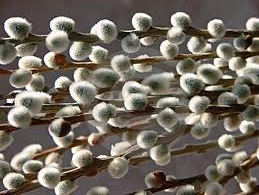![]() Prices in Canadian Dollars.
Prices in Canadian Dollars.![]() Prefer to call and speak to a floral agent? 1-877-277-4787
Prefer to call and speak to a floral agent? 1-877-277-4787
Picking Pussy Willows
Picking Pussy Willows
There are a large number of willows growing wild all over Alberta, and they are generous and willing to be collected by someone with the right touch. Pussy Willow picking is a healthy, interesting and fun pastime for teenagers, retirees, out of work landscapers and gardeners and nature buffs who need an excuse to go out for a walk in the woods. The willows don’t mind, as they just grow new stems from the old, and are ready to be picked again next year. The willows grow freely all along the roadsides in Alberta so there is little environmental concern about endangering a rare species.
WHERE ARE THEY?
Pussy Willows grow in low, wet areas, all over Alberta. There are about 40 different species growing in Alberta and at least 20 close to Edmonton. All but a handful of species produce beautiful pussy willows. Many types of willows can be used for weaving baskets and wreaths, or just to enjoy their brightly coloured stems.
VARIETIES
The first to come out in early February, have red stems and very white Flowers. They are branchy, not always fully Flowered and prefer more watery sites. They are attractive, however, and well worth picking.
The main season varieties, blooming in March, include mostly brown, or brown/grey stems with silver/grey Flowers. This group includes the largest Flowering types. You can find 7 foot stems, ½” in diameter stems, ½” Flowers. Look for old, heavy trees for the biggest stems and pussies. Old trees need the most pruning, but will reward you next year.
The latest to Flower, at the end of March and early April, include some very nice brown/orange stems with large, white Flowers. Many mid season types will still be Flowering if they have been short of water, or in a cool location. The Wolf Willows have small, grey Flowers on very colourful, green, yellow & red stems.
BIOLOGY
The pussies are the Flowers of willow bushes. Their survival strategy is to bloom before other Flowers are available and so reduce competition for insect pollinators. The fuzz protects the developing Flowers inside from frost damage. Deep roots can move water and nutrients to the shoots even in cold weather.
We will be picking the Flowers before they are fully, reproductively mature. Fully mature Flowers will produce pollen bearing anthers which extend out of the Flower into the air for pollen dispersal. Don’t pick these. They are easy to identify because they have a yellow blush and if you look closely you can see the anthers. This means the season is over for this variety.
FORCING
Stems with unopened buds can be forced into Flower by re-cutting stems underwater and holding in water in a warmer (60 – 65 F) environment.
TIME
At a good site you should be able to pick at least 15 bundles per hour once you are set up. Don’t spend too much time looking for the perfect bush. Bushes that look small from the road are usually much larger up close. Try to spend at least l/2 hour at a given spot.
QUALITY CONTROL
Always go for best quality. There are so many willows available, it is a waste of time to pick any but the very best.
WATER
Willows like to grow beside or even in the water. Wear rubber or waterproof boots. Be careful of falling through ice into deeper water. Bring extra socks and boots with you.
FLORIST STANDARD BUNDLES
The standard florist quality pussy willows should have medium to large Flowers, straight stems 2 to 3 feet long, with Flowers evenly along the stem all the way to the tip. A 6″ – 8″ bare section of stem is OK at the bottom end.
Look for unusual shapes, or types of plants, and especially good varieties. Some will be suitable for cultivation. All types must have Flowers evenly spaced all the way to the tip.
EQUIPMENT
To be fully prepared you should have the following:
- good quality pruning shears
- rubber bands in 2 or 3 sizes
- a drop cloth, not plastic, sheet size
- lots of gloves, socks, sweaters, hats, etc.
- a friend to go with you rubber boots or waterproof winter boots
- boxes or more cloths to load bundles
- food and drink and first aid, bandaids
- a 2 – 3 m pole with a hook screwed into the end for grabbing branches.
- large tree loppers, long handles – optional – $45 each
PICKING
We have developed a system for maximum productivity from a given site:
- Cut l” diameter branches, with tree loppers, or large pruning shears. A clean cut will produce 5 or more new, long, straight shoots next year. On your own property, or sites you plan to return to, take time to cut off diseased or dead branches and prune the bush a bit, to make it more productive in following years. It is easy to bend larger branches down with your “hook on a stick” to reach the top. Be careful not to crack the main stem.
- Holding the bottom of the large branch in one hand, cut the best, suitable branches, into separate piles of long straight, standard straight, and standard branched. You will occasionally find large branched stems that are well shaped even though they are 2 – 3 m tall. Put these aside for use as Easter Trees or window display materials. Make piles onto a drop sheet so you don’t have to work in the snow. Discard the leftover cut stem in a non-obstructive way, at the bottoms of the bushes, or the fence line, in a neat pile.
- Branched bundles can be tied with an elastic half way up the stems. Careful not to break off the Flowers.
STORAGE
Store outside, in the shade, cold, but out of the wind. Don’t need to put them in water.
OTHER PEOPLES’ PROPERTY
You can find enough pussy willows in open areas and should not need to cross anyone’s fence, or cut bushes that may be part of their view. Ask permission first.
ROADSIDES
Working on roadsides is dangerous. Be careful of traffic. Women should never pick by themselves, take a friend. Park carefully, snow banks can be deceptive. Look for field turn offs for parking. Be careful of locking yourself out of the car, or leaving the lights on. Before you leave a site make sure you have all of your tools, equipment, mitts, and bundles.
TWIGS
Dogwood is popular at Christmas, Birch twigs are used for swags and wreaths, coloured Willow twigs are used in floral arrangements and window displays, mostly in the fall. Alder, Prunus, and many others are useful in swags and sprays. For Christmas there is always a demand for evergreen branches, cedar, fir, some spruce, pine and so on. Don’t forget about spring Flowering trees and shrubs that can be cut in the winter and forced into early bloom.
Pick from late fall until early spring. Look for interesting shapes, colours and textures. Also look for standard shapes (straight, branched at the top, etc), colours (red dogwood, yellow, orange, red willow), and textures (fine birch). The bundles should be tidy looking, with a clean straight bottom for a handle. Tie with elastic bands. Most types should be 2 – 3 feet tall. A bundle is usually one handful of stems.
Alder – has nice, small cones in winter, and these are attractive in swags.
Aspen Poplar – Not good in winter, but very nice in early summer for leafy wreaths and swags. Same construction methods as for other wreaths, just use fresh green leafy branches and allow to dry.
Birch – Do not cut in early spring. The trees will bleed sap and can be seriously damaged from too much cutting at this time. This is a very popular one and can be used for many different products, including just bundles. Fine, much branched twigs are best. Weeping Birch is very nice.
Dogwood – Choose twigs with the best red colour. Avoid branches with grey scars or damaged bark. Younger ones will be the best. These are very good for wreaths and swags. This is worth cultivating in long hedgerows for continuous cutting.
Evergreens – Pine is good, but sticky. Best with some cones on the branches, and good colour. Fir is very nice, try to get full branches with good colour. Spruce is not very useful. Can make up your own wreaths and swags. Same constructions methods as for twig wreaths and swags.
Prunus species – Chokecherry, Apple, Crab Apple, many other bushes have attractive branch shapes or colours. Small, fine branched and coloured twigs are very popular for swags. Many of these trees and shrubs produce beautiful Flowers in the spring. If you cut budded stems in early January, you can hold them in water in a sunny place and the buds will develop into the earliest spring flowers,.
Willow – Coloured twigs of Moose Willows are popular. A bundle of nicely coloured and shaped willow twigs will dry into a very elegant arrangement for a big clay pot. Some special sizes and types for willow furniture making and willow basketry. Willows are the best for making wreaths and swags. Look for Diamond Willow (Salix discolor) for making walking sticks and furniture.


